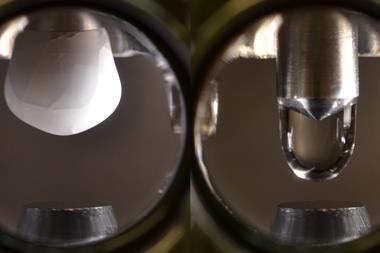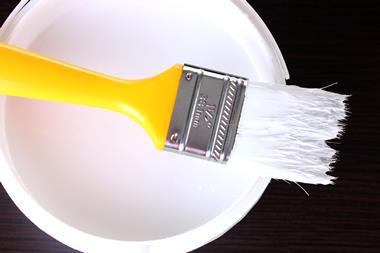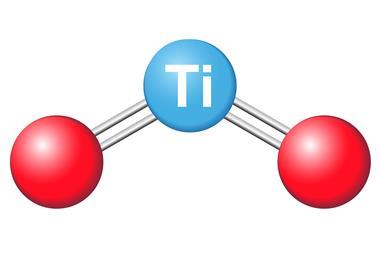With potential health concerns raised over nanosize forms of TiO2, Emma Davies explores the ubiquitous white pigment’s past, present and future

With its national reputation for cleanliness, Japanese toilet manufacturer Toto has put titanium dioxide (TiO2) to good use, with self-cleaning toilets. The ‘intelligent’ toilets have a photoactive titanium dioxide coating that breaks down organic matter and are now beginning to make a splash in the US and Europe, if a 2016 consumer electronics show in Las Vegas is anything to go by.
Although largely used as a pigment, TiO2 continues to appeal to researchers developing self-cleaning, anti-microbial products, thanks to the fact that it acts as a photocatalyst when exposed to UV light. Its photocatalytic history began in Japan in the 1970s, and is still being built on today, with work to create more efficient dye-sensitised solar cells (DSSCs).
In 1916, the Titanium Pigment Corporation of Niagara Falls in the US and Titan in Norway began commercially producing TiO2 pigment for use in paints. A century on, its main applications are still as pigments – in paints, plastics and rubber, paper, inks, cosmetics and pharmaceuticals. Indeed, of the six million tonnes produced globally each year, 99% is used in pigments, according to the Titanium Dioxide Manufacturers Association (TDMA). ‘As a pigment, TiO2 has by far the highest refractive index of any white material and that’s what gives it its pigmentary power,’ says Tony Jones, global technology fellow at Huntsman Pigments and Additives in Stockton-on-Tees, UK. ‘There’s nothing really to substitute for it.’
Titanium dioxide often makes the market pages of financial newspapers, with dramatic price fluctuations. As recently as 2011, a huge shortage of the material doubled prices. Supply has since increased to the point of oversupply and prices have tumbled, causing spin-offs and consolidation in the industry.
Daily dose
The chances are that you will use a TiO2-containing product every day, from the moment you squeeze the toothpaste tube in the morning, to when you idly reach for a piece of chewing gum, slap on sun cream, or swallow a tablet.
There’s no substitute for titanium dioxide
With such a ubiquitous material, health concerns are perhaps inevitable. In 2006, the International Agency for Research on Cancer classified titanium dioxide as a possible human carcinogen (category 2B), based on the results of a rodent study, with ‘insufficient evidence of carcinogenicity in humans’.
In 2013, the French Agency for Food, Environmental and Occupational Health and Safety (Anses) announced its intention to evaluate whether TiO2 poses a health risk, under the EU’s Community Rolling Action Plan.
Evaluation has yet to begin but could lead to EU-wide risk management measures, including authorisation under Reach (registration, evaluation, authorisation and restriction of chemicals) legislation. Anses also recently submitted a proposal to the European Chemicals Agency (ECHA) to classify TiO2 as a category 1B carcinogen; the ECHA will process the Anses dossier before a public consultation is launched.
Should it go through, the classification could have a serious impact on industry, with the possibility of restricted use in consumer applications. The TDMA ‘does not agree with the proposal based on the extensive work carried out for the Reach registration’. This includes epidemiological studies of 20,000 workers in 15 titanium dioxide manufacturing plants over decades. They found no evidence that TiO2 has carcinogenic effects in human lungs. The association ‘will carefully review the Anses proposal when it is published and provide a detailed response to the ECHA public consultation’.
Despite the fact that TiO2 particles need to be larger than the EU-defined 100nm to work as a pigment, some researchers and non-governmental organisations have raised health concerns over possible exposure to titanium dioxide nanoparticles in foods. The European Food Safety Authority is currently re-evaluating TiO2, as food ingredient E171, with a report due this year.
Gut feeling
A 2015 study commissioned by Friends of the Earth reported finding nanosized TiO2 particles in 14 popular food products, including confectionery. Meanwhile, a US team, led by Yu Yang from Arizona State University, also claims to have identified nanoparticles in food-grade TiO2 samples.

In the same year, a UK Medical Research Centre (MRC) study suggested that TiO2 particles ingested from the diet and pharmaceutical products can cross from the gut into the bloodstream. Eight healthy volunteers swallowed capsules containing 100mg of titanium dioxide. A team from the MRC’s Elsie Widdowson Laboratory in Cambridge then used dark field microscopy to identify particles in the blood. Particles showed up two hours after ingestion, peaking at six hours.
‘Our prior work implies that little by little these particles accumulate with age in lymphoid patches [in the gut],’ says Jonathan Powell, who led the study. He suspects that while some particles are taken up by these regions, called Peyer’s patches, others pass into the blood stream.
The UK Food Standards Agency (FSA) funded a similar study, published in 2015, suggesting that ‘very little titanium dioxide is absorbed gastrointestinally’ after being ingested. Researchers at the University of Oxford and the Health and Safety Laboratory in Buxton gave nine volunteers three different doses of titanium dioxide, spaced at least four weeks apart. Their results suggest that there is ‘no evidence that nanoparticulate titanium dioxide is more likely to be absorbed from the gut than micron-sized particles’.
Few human studies have been published in this area and there are some discrepancies in baseline levels of TiO2 measured in samples. For example, samples in the FSA study showed a relatively high background level of TiO2, which could be due to a limitation of the analysis technique used, lead researcher Kate Jones concedes. ‘However, it is still likely that there is a significant background exposure from consumer and environmental sources,’ she says.
To help understand such differences in background TiO2 levels and analytical techniques, Powell’s team is currently organising a round-robin study of human blood samples by eight different laboratories around the UK and Europe. Some of the samples have been spiked with secret levels of TiO2.
‘Nobody has been able to measure the nanoparticles in blood,’ explains Sylvaine Bruggraber from the MRC. ‘That’s something that we have started doing with single-particle inductively coupled plasma mass spectrometry.’ The MRC team plans to run a human study using new techniques, including a flow cytometry method, to analyse TiO2 in human blood. ‘We are hoping to combine different techniques to show whether titanium in whole blood is present as nanoparticles,’ she says.
If titanium dioxide pigment does contain particles smaller than 100nm, it is unintentional. Given that a particle scatters light at about twice the wavelength of its diameter, a crystal size of about 250nm is required to optimise visible light scattering, explains Hunstman’s Jones.
Nevertheless, there is always a distribution of particle sizes, and industry and academics have struggled to find a reliable way to characterise nanoparticles. ‘Because the EU nano definition is based on a number percentage, you end up doing electron microscopy and counting crystals,’ says Jones.
When titanium dioxide is very thin, you can’t see it
The situation for sun creams is slightly different. These need ‘ultra-fine’ TiO2 nanoparticles to minimise visible light scattering and white appearance, while maximising scattering and UV absorption. In the US, the Food and Drug Administration already restricts TiO2 use.
For some, the issue is whether the nanoparticles, with their potential to cause free radicals to form, can penetrate the skin. A large number of studies suggest that this is not the case, but a recent small-scale Norwegian study based at Oslo University Hospital suggested that the nanoparticles can penetrate skin to reach ‘viable cells’ in the epidermis. The team, led by Elise Naess, now calls for larger-scale, real-life simulation studies on humans using nanoparticle-containing sunscreens.
Self-cleaning
As a photocatalytic material, TiO2 remains widely studied in academia, for applications including water and air purification, water splitting, and self-cleaning materials. Exposing it to UV light promotes an electron into its conduction band, leaving behind a ‘hole’ that travels to the crystal surface, where it can generate highly reactive hydroxyl radicals with the ability to degrade organic materials.
To minimise titanium dioxide’s photocatalytic effects in paints, the pigment is commonly coated with the hydrous oxides silica or alumina. Paul Christensen, from Newcastle University’s School of Chemical Engineering and Advanced Materials, worked for many years with Huntsman and other companies to find ways to monitor the decay of paint and polymers in sunlight. ‘If you look at south-facing windows, you will see the paint flakes and powders and that’s because of the TiO2 harvesting 5% of the solar spectrum in the UV,’ he says.

At least four commercial window glass products make use of titanium dioxide’s photocatalytic action, including Pilkington Activ, developed in 2001. All of them have a thin coating of titanium dioxide to create a super-hydrophilic surface, which causes rain to form sheets that wash dirt off uniformly. Meanwhile, under the action of sunlight and rainwater, the photocatalytic properties of TiO2 help to degrade any dirt on the surface.
‘What always surprises me is that titanium dioxide is used as a whitener, with one of the highest opacities, and yet, when it’s very thin, you can’t see it,’ says Ivan Parkin, head of University College London’s chemistry department, who has published 100 research papers on the material.
In 2015, Parkin’s team reported a self-cleaning paint that uses titanium dioxide as a scaffold material. This time, they created a super-hydrophobic surface using a fluorinated polymer. ‘Instead of water sheeting on the surface, it forms a ball that rolls on the surface. This ball acts as a miniature vacuum cleaner, picking up dirt, bacteria and viruses in a rolling motion and transporting them across the surface to be completely removed,’ explains Parkin.
Photo finish
Titanium dioxide photocatalytic technology evolved in Japan in the late 1960s when Akira Fujishima and Kenichi Honda from the University of Tokyo found a way to electrolyse water using a titanium dioxide semiconductor electrode and solar energy. When the results were published in Nature in 1972, the world was in the midst of an oil crisis and TiO2 photocatalysis grabbed global attention as a way to generate power with solar energy.
Eventually, the oil crisis passed and the TiO2 fever died down, partly because the material’s quantum efficiency is not that good, says Christensen. ‘That’s when the idea of using titanium dioxide for detoxification came up,’ he adds. For many years, teams worked on using TiO2 to destroy pollutants through release of OH radicals. Yet removing the catalyst once it had done its job remained a tough problem.
Pretty much every dye-sensitised solar cell uses titanium dioxide
In 1991, Michael Grätzel and colleagues from the Swiss Federal Institute of Technology in Lausanne published the first paper on using TiO2 to transport electrons in dye-sensitised solar cells (DSSCs). These use a layer of dye adsorbed onto TiO2 in an electrolyte solution, sandwiched between electrodes. The dye layer absorbs sunlight, exciting electrons, which diffuse across the TiO2 film to the electrode.
In 2013, Grätzel’s lab made another significant breakthough with solid state DSSCs, replacing the liquid electrolyte with a hole-conducting material. DSSCs have distinct advantages of being low cost, flexible and robust, as well as the option of transparency. They also rely on fairly abundant and inexpensive materials. Recent months have seen scientists working on different dye sources, including vegetable dyes extracted from algae, flowers, fruit and leaves. ‘Pretty much every DSSC uses TiO2 – not as a capture layer but to facilitate electron transport,’ says Parkin.
But the fact remains that titanium dioxide is not all that efficient at using sunlight. Doping with other elements improves the ability of TiO2 to absorb in the visible. ‘We have done that with phosphorus, nitrogen and sulfur,’ says Parkin.
‘One big area we have looked at is making self-cleaning, but also self-sterilising, surfaces using titanium dioxide and other materials,’ he says. ‘If we dope titanium dioxide with nitrogen and sulfur then it can have quite potent anti-microbial properties. Indeed the nitrogen-doped one just about works with visible light – you don’t need sunlight or UV to get it to work.’
Water-splitting remains one of the ‘biggest research areas at the moment’, says Parkin. ‘The problem is that you need to have quite high energy to be able to photo-activate TiO2,’ he adds. Doped TiO2, multiple layered systems, or completely new ones are all current options. Even in new systems, researchers are turning to it as a protective layer to prevent photocorrosion.
It would appear that TiO2 will always have a role to play. For Parkin, titanium dioxide is, and will no doubt remain, his favourite material.
Emma Davies is a science writer based in Bishop’s Stortford, UK












1 Reader's comment